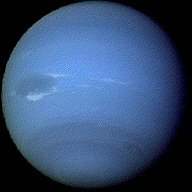
 |
Neptune - ice giant |
|
| |

Vital StatsPredicted DiscoveryNeptune was found when astronomers Adams and Leverrier separately calculated the position of a new planet which they thought was altering the orbit of Uranus. Neptune was first observed by Galle in 1846. Even after its discovery, the orbits of Uranus and Neptune were still different from what astronomers thought they should be. This led to the search for yet another planet... Rings or Ringlets?
The planet has two main moons: Triton with a diameter of 2,720km, and Nereid only a few hundred km across, and in a highly elliptical orbit. Triton is a very dense moon and very cold, with a surface temperature of -236°C. Its surface is shrouded in nitrogen and methane ice, and has a polar cap covered with pink 'snow'. Six more moons were discovered to lie close to the planet within its rings, by Voyager 2. Winds!Despite being so far away from the Sun, Neptune has considerable internal heating due to its mass. This provides enough energy to drive 1,100km/h winds in the planet's atmosphere, which is mainly composed of hydrogen (85%), helium (13%) and methane which is visible as white 'cirrus-like' clouds high up in the atmosphere. |
Surprising FeaturesOther features can be seen such as a large dark spot rotating in the southern hemisphere. This feature is similar in nature to the Great Red Spot on Jupiter. Like Uranus, Neptune has a magnetic field inclined to the rotational axis by a surprising amount, in this case 50°, and also offset from the planet's centre by some 10,000km.Stormclouds Gathering!
Sole VisitorThe only spacecraft to visit Neptune so far has been Voyager 2, in 1989, when it made its last encounter with a planet in our solar system. Despite a journey lasting 12 years, Voyager returned data and high-resolution colour images of excellent quality, revealing Neptune and its moons as magnificent sights at the boundary of our place in the Galaxy. See Voyager 2 Schematics. Map of Neptune | Mythical Icons | |||||||
|
Sun | Mercury | Venus | Earth | Moon | Mars | Asteroids | Jupiter | Saturn | Uranus | Neptune | Pluto | X | Kuiper | ||||||||